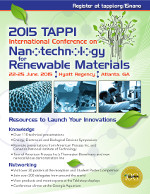Green Electronics from Renewable Nanomaterials
 Renewable materials from nature are emerging as attractive solutions to create flexible, lightweight, cost efficient, renewable, and biocompatible devices. In particular, nanocellulose materials are not only biocompatible and earth-abundant but also have nature-provided intrinsic structures for potentially transformative performance.
Renewable materials from nature are emerging as attractive solutions to create flexible, lightweight, cost efficient, renewable, and biocompatible devices. In particular, nanocellulose materials are not only biocompatible and earth-abundant but also have nature-provided intrinsic structures for potentially transformative performance.
This June, TAPPI’s 2015 International Conference on Nanotechnology for Renewable Materials is shining a spotlight on this new technology area. Two expert scientists, Dr. Liangbing Hu, Univ. of Maryland College Park, Dept. of Materials Science and Engineering, and Dr. Junyong Zhu, USDA Forest Product Lab have organized a special symposium on Nanocellulose Materials and Their Applications in Energy, Electronics and Biological Devices.
Scheduled for Wednesday, 24 June 2015, Hu and Zhu have assembled 20 leading experts to provide a forum for scientists and engineers working in nanocellulose materials to communicate recent progress on current technologies and to exchange ideas about next-generation solutions.
Topics to be presented include:
View the complete technical program to plan your time at the conference. Register by 10 April for the best rates.
 Renewable materials from nature are emerging as attractive solutions to create flexible, lightweight, cost efficient, renewable, and biocompatible devices. In particular, nanocellulose materials are not only biocompatible and earth-abundant but also have nature-provided intrinsic structures for potentially transformative performance.
Renewable materials from nature are emerging as attractive solutions to create flexible, lightweight, cost efficient, renewable, and biocompatible devices. In particular, nanocellulose materials are not only biocompatible and earth-abundant but also have nature-provided intrinsic structures for potentially transformative performance. This June, TAPPI’s 2015 International Conference on Nanotechnology for Renewable Materials is shining a spotlight on this new technology area. Two expert scientists, Dr. Liangbing Hu, Univ. of Maryland College Park, Dept. of Materials Science and Engineering, and Dr. Junyong Zhu, USDA Forest Product Lab have organized a special symposium on Nanocellulose Materials and Their Applications in Energy, Electronics and Biological Devices.
Scheduled for Wednesday, 24 June 2015, Hu and Zhu have assembled 20 leading experts to provide a forum for scientists and engineers working in nanocellulose materials to communicate recent progress on current technologies and to exchange ideas about next-generation solutions.
Topics to be presented include:
- Mechanical and optical properties of Oji Holdings’ cellulose nanofiber transparent, flexible films and its potential uses in flexible organic light emitting displays, foldable solar cells and TFT substrates
- VTT’s new technology for producing supercapacitors for flexible and wearable devices from nanofibrillated cellulose.
- US Forest Service’s work on flexible, magnetostrictives membranes from nanocellulose
- Osaka University’s nanopaper production for use in memory, transitor, high dielectric constant, transparent conductive, and foldable antenna devices
- Georgia Tech’s work on evaluating cellulose nanofibers as substrates for organic field-effect transistors
- McMaster University’s strong, flexible and free-standing supercapacitors made from cellulose nanocrystal aerogels
- Ulsan National Institute of Science and Technology reports on a unitized separator/electrode assembly architecture made of celluloe nanofibrils, for use in lithium-ion batteries.
- Rutgers University’s lastest work on tuning electromechanical properties of paper for electrical elements and flexible circuit boards.
- Oregon State University’s new methodology for forming highly nanoporous carbons from biomass for capacitive electrodes in supercapacitors.
- Univeristy of Maryland’s development of transparent paper substrates and design rules for achieving tailored optical and mechanical properties for use in flexible electronics and solar cells.
View the complete technical program to plan your time at the conference. Register by 10 April for the best rates.














